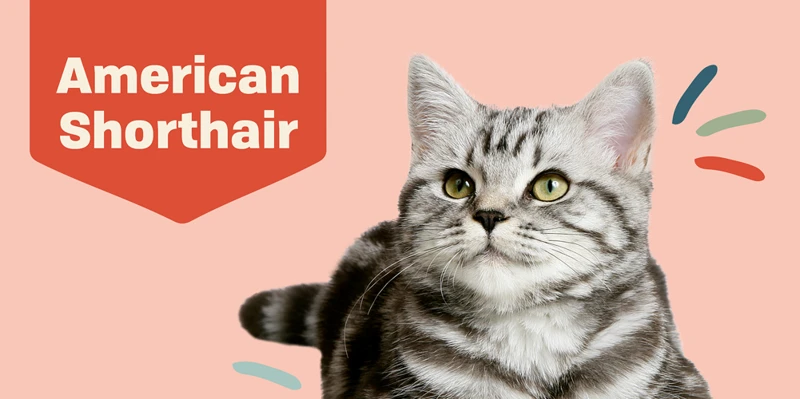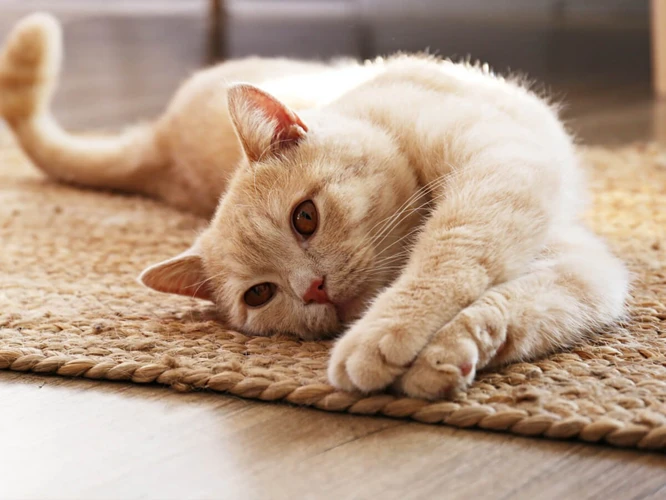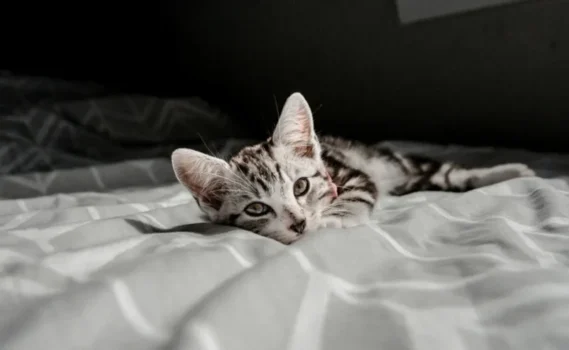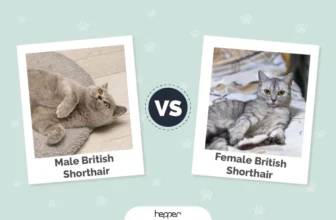As a cat owner, you know that American Shorthairs are intelligent and independent creatures. However, simply having a feline companion isn’t always enough, as we often want to connect with them and teach them new skills. Teaching your American Shorthair basic commands using positive reinforcement can be a great way to create a bond with your cat while also giving them mental stimulation. In this article, we will explore why positive reinforcement is the way to go when it comes to training your cat and share step-by-step techniques to help you and your cat succeed in learning basic commands.
Why Use Positive Reinforcement?

When it comes to training your American Shorthair, you may be wondering which method to use. While there are different approaches, using positive reinforcement has proven to be effective and humane. Positive reinforcement is a training technique that rewards desired behavior, increasing the likelihood of it being repeated in the future. But what exactly is positive reinforcement, and why is it so effective? Let’s take a closer look.
What is Positive Reinforcement?
Positive reinforcement is a widely used training method that rewards desirable behavior to encourage repetition. Simply put, positive reinforcement is the act of adding something desirable in response to a positive action. Cats are highly receptive to this kind of training.
Examples of positive reinforcement for cats include:
- Giving treats and food rewards
- Offering praise and positive attention
- Providing favorite toys or engaging in playtime
Using positive reinforcement during training creates a positive association with good behavior, which encourages cats to repeat those behaviors. As a result, training becomes an enjoyable experience for both you and your cat. Additionally, positive reinforcement helps to build trust and strengthen the bond between you and your feline friend.
It is important to note that positive reinforcement should be used in conjunction with clear communication and consistency. By pairing desired behavior with rewards consistently, your cat will be more likely to remember what is expected of them and work to achieve it.
For more information on positive reinforcement training for American Shorthairs, check out our article on Positive Reinforcement Training for American Shorthairs. This article outlines the benefits of using treats during training in greater detail, as well as how to train your cat to use a scratching post, and the benefits of positive reinforcement for anxious cats.
Why is Positive Reinforcement Effective?
Positive reinforcement is one of the most effective ways to train your American Shorthair cat. It involves rewarding your cat for exhibiting good behavior and ignoring bad behavior. But why is positive reinforcement so effective? Let’s take a look at some of the reasons in the table below.
| Reasons Why Positive Reinforcement is Effective |
|---|
| Increases Motivation |
| When your cat knows that good behavior will be rewarded, they become more motivated to perform the desired behavior. This increases their willingness to learn and makes the training process more efficient. |
| Strengthens Positive Associations |
| Positive reinforcement strengthens the bond between you and your cat. When your cat associates good behavior with positive experiences, they are more likely to repeat the desired behavior and will look to you for guidance and positive experiences in the future. |
| Reduces Anxiety and Fear |
| Using positive reinforcement reduces the anxiety and fear that is often associated with punishment-based training. By rewarding good behavior, your cat feels more confident and relaxed during training, and less fearful of making mistakes. |
| Encourages Creativity and Problem Solving |
| Positive reinforcement encourages your cat to be creative and solve problems in order to receive rewards. This stimulates their cognitive abilities and helps build their confidence in their own problem-solving skills. |
When you use positive reinforcement to train your American Shorthair, you will likely see faster and longer-lasting results. Additionally, it can contribute to a happy and healthy relationship between you and your cat. So, it’s a win-win for everyone! If you want to learn more about using treats for training American Shorthairs, you can check out our article on Using Treats for Training American Shorthairs. Or, if you’re looking to train your cat to use a scratching post, read our article on Training Your American Shorthair to Use a Scratching Post. Finally, if you are dealing with an anxious cat and want to know more about the benefits of positive reinforcement training, read our article on Benefits of Positive Reinforcement Training for Anxious Cats.
Teaching Basic Commands

Teaching your American Shorthair basic commands can be a challenging but rewarding experience. It’s a great way to bond with your furry friend, and it can also be a useful tool for managing behavior. In this section, we’ll explore the step-by-step process of teaching your cat basic commands using positive reinforcement techniques. By following these tips and tricks, you’ll be able to teach your cat new skills and strengthen your relationship with one another. So, let’s dive in and get started!
Choosing Commands to Teach
When choosing which commands to teach your American Shorthair, it’s important to consider their personality and abilities. Start by picking a few basic commands and gradually adding more advanced ones over time. Here are some guidelines for choosing commands to teach:
| Considerations: | Examples of commands: |
|---|---|
| Commands that will keep your cat safe and healthy. | “No” or “Stop” to prevent them from eating harmful objects, “Come” to recall them if they accidentally escape outside. |
| Commands that will help you care for your cat. | “Sit” to make it easier to groom them or give them medication, “Stay” when you need them to remain still. |
| Commands that will improve your cat’s behavior and strengthen the bond between you. | “High five” or “Shake” to encourage physical interaction between you and your cat, “Lay down” or “Roll over” to increase their obedience and flexibility. |
Remember to start with simple commands and gradually increase difficulty as your cat becomes more comfortable and consistent. Also, keep in mind that some commands may come more naturally to certain cats, so be patient and adjust your teaching approach accordingly.
Preparing for Training
Before starting the training process, it’s important to prepare your American Shorthair cat and the training environment for the best results. Here are some tips to prepare for the training session:
1. Create a Distraction-Free Environment: Choose a quiet room where there are no distractions, such as loud noises, other pets, or people. It will help your cat to focus on the training.
2. Get the Right Equipment: Before beginning the training sessions, make sure to have the right training equipment, such as a clicker, treats, and a leash. You can also use toys to motivate and reward your cat.
3. Choose the Right Time: The right time for training is when your cat is alert and well-fed. Cats are often active after they have been fed, so it’s a good time to start training. Also, when your cat has a lot of energy, it will be easier to get them to focus on training.
4. Start with Short Sessions: Start with short 5-10 minute training sessions, and slowly increase the duration as your cat becomes more engaged and focused.
5. Use Positive Reinforcement: Use positive reinforcement techniques, such as treats and praise, to reward your cat for following your commands. This will motivate them to learn and make training sessions more enjoyable for both of you.
Here is a table summarizing the preparation tips:
| Preparation Tips: | |
|---|---|
| Create a Distraction-Free Environment | Choose a quiet room where there are no distractions, such as loud noises, other pets, or people. |
| Get the Right Equipment | Before beginning the training sessions, make sure you have the right training equipment, such as a clicker, treats, and a leash. |
| Choose the Right Time | Train your cat when they are alert and well-fed. When your cat has a lot of energy, it will be easier to get them to focus on training. |
| Start with Short Sessions | Begin with short 5-10 minute training sessions, and slowly increase the duration as your cat becomes more engaged and focused. |
| Use Positive Reinforcement | Use positive reinforcement techniques, such as treats and praise, to reward your cat for following your commands. This will motivate them to learn and make training sessions more enjoyable for both of you. |
By following these preparation tips, you can ensure that your American Shorthair cat is ready for training and that the training sessions are effective and enjoyable for both you and your furry friend.
Training Techniques
When it comes to training your American Shorthair, there are a few key techniques that are most effective when using positive reinforcement. Here are some training techniques to keep in mind:
- Clicker Training: Clicker training is a popular training method that involves using a clicker to make a distinct sound when your cat performs the desired behavior. This is then followed by a treat. Over time, your cat will associate the sound of the clicker with receiving a reward, and will be more likely to repeat the behavior in the future.
- Target Training: Target training involves using a stick with a target (such as a ball or a small circle) attached to the end. Hold the target in front of your cat and when she touches it, reward her with a treat. With repeated practice, you can gradually move the target further away and get your cat to move or jump to reach it.
- Luring: Luring is a technique that involves using a treat to guide your cat into the desired position. For example, if you want to teach your cat to sit, hold a treat near her nose and slowly move it upward over her head. As her head moves up, her bottom will naturally move down into a sitting position. Once she is in the correct position, say “sit” and give her the treat.
- Shaping: Shaping involves gradually shaping a behavior by rewarding your cat for small steps towards the desired end goal. For example, if you want to teach your cat to jump through a hoop, start by rewarding her for walking towards the hoop, then standing next to it, then putting a paw through, and so on. With repeated practice, your cat will learn to jump through the hoop.
- Chaining: Chaining involves linking several behaviors together to form a sequence. For example, if you want to teach your cat to go to her bed and then lie down, you might start by rewarding her for going to her bed, then for putting her front paws on the bed, then for lying down on the bed, and so on. With repeated practice, your cat will learn the entire sequence of behaviors.
Remember to always use positive reinforcement, such as treats or praise, to reward your cat for good behavior. This will help her to enjoy the training process and look forward to learning new commands.
Maintaining Consistency
Maintaining consistency is crucial when teaching your American Shorthair basic commands. Your cat needs to fully understand what is expected of them, and this can only be achieved through repeated and consistent training sessions. Below are some tips on how to maintain consistency during your cat’s training sessions:
| Create a Training Schedule | Consistency starts with scheduling. Set a specific time and place for your training sessions. This will help your cat develop a routine and a habit of expecting training during certain times of the day, making them more receptive to learning. |
|---|---|
| Use the Same Commands | Using the same commands for each behavior is important. Once your cat has learned a command, use it consistently in each of your training sessions. This will help your cat understand the behavior expected of them and what the associated command means. |
| Consistent Rewards | Be consistent with your rewards. Whether it’s verbal praise, treats, or playtime, your cat should receive the same reward each time they successfully perform the desired behavior. This consistency will reinforce learning, and your cat will be more likely to continue the behavior. |
| Avoid Mixed Messages | Avoid mixed messages by making sure that everyone in your household understands the commands and rewards you are using to train your cat. Inconsistencies in messaging can confuse your kitty and hamper learning, so make sure everyone is on the same page. |
| Persistence Pays Off | It can take time before your cat learns a new behavior, but persistence pays off. Continue to practice with patience and consistency, and eventually, your cat will understand what is expected of them. Remember, positive reinforcement is about rewarding behaviors you want to encourage, so keep at it and celebrate every milestone! |
By following these consistency tips, you’ll be able to keep your American Shorthair cat engaged and motivated during training sessions and ensure their success. Don’t forget to stay positive and remain persistent, and you’ll be amazed at how quickly your kitty responds to your training efforts.
Troubleshooting Common Challenges

As with any training process, teaching your American Shorthair basic commands using positive reinforcement may come with its own set of challenges. Despite your best efforts, it is possible that your furry friend may not respond as expected or may get distracted during training sessions. But don’t worry – these common obstacles can be overcome with a little creativity and patience. In this section, we will explore some common challenges that pet owners face during training and provide tips on how to troubleshoot these situations. So let’s dive in and solve these perplexing problems!
My Cat Won’t Respond to Commands
If your American Shorthair is not responding to your commands, don’t worry; it’s a common challenge for pet owners. Here are some possible reasons why your cat may not be responding and practical solutions to help overcome the issues:
- Lack of Motivation: Just like humans, cats may not feel like training. If your cat seems uninterested, try using a higher-value treat that will motivate them to participate.
- Training Fatigue: Your cat may be losing focus and becoming fatigued during lengthy training sessions. Try reducing the length of your training sessions and increasing the frequency of shorter sessions to prevent training fatigue.
- Distractions: Cats can be easily distracted by their surroundings, which may draw their attention away from your commands. Try training your cat in a quiet, distraction-free environment.
- Inconsistent Commands: Cats are intelligent animals, but if training is not consistent, they may become confused. Ensure that everyone in the household is using the same commands and training methods to prevent confusion.
- Fear and Anxiety: If your cat is fearful or anxious, they may not want to participate in training. Try working on building a bond of trust with your cat, and gradually introduce training sessions to help them feel more comfortable.
It’s essential to approach training with patience and an open mind. If your cat still seems unresponsive, it may be helpful to consult with a professional trainer or veterinarian for further guidance and support. Remember, every cat is unique and may respond differently to training techniques, so keep experimenting until you find what works best for you and your feline companion.
My Cat Gets Distracted During Training
When training your American Shorthair cat, it’s possible they may get distracted and not respond to commands. This can be frustrating, but there are a few strategies you can try to keep your cat focused on the training.
1. Find a Quiet Location: Cats can be easily distracted by noise and movement, so finding a quiet location for training is essential. Try selecting a room with few distractions, such as doors or windows.
2. Break Up Training Sessions: Cats have short attention spans, so breaking up training sessions into shorter, more frequent sessions can be helpful. Try to keep each session between 5-10 minutes to keep your cat focused.
3. Use High-Value Rewards: If your cat is getting distracted, it may be because they aren’t motivated by the rewards you’re offering. Try switching to high-value rewards, such as small pieces of meat or cheese, to keep your cat engaged.
4. Keep Training Positive: If your cat is feeling stressed or unhappy during training, they will be more likely to become distracted. Keep training sessions positive and upbeat by using an encouraging tone of voice and rewarding your cat for every small success.
5. Try Different Training Techniques: If one training technique isn’t working, don’t be afraid to try something new. You can try clicker training or using a target stick to keep your cat focused. Experimentation can help you find what works best for your cat.
By using these strategies, you can help keep your American Shorthair cat focused during training and increase their ability to respond to basic commands over time. Remember to be patient and consistent in your training efforts, as these skills can take time to develop.
Moving Beyond Basic Commands
As your American Shorthair becomes more skilled with basic commands, it’s time to move beyond the basics and further challenge their intelligence and obedience. There are several ways to achieve this, including using more complicated commands, incorporating new training tools, and providing new types of rewards.
Introducing More Complicated Commands: Once your cat has mastered basic commands like “sit” and “stay,” it’s time to add new commands to their repertoire. Consider teaching them commands like “come,” “roll over,” or “high five.” These commands require more complicated movements and can help keep your cat mentally engaged during training sessions.
Incorporating New Training Tools: Adding new training tools to your arsenal can also help you teach your cat new and more advanced commands. One example is a clicker, a small device that makes a clicking sound when pressed. By pairing the sound of the clicker with a reward, your cat will learn to associate the sound with positive reinforcement, making training more effective.
Providing New Types of Rewards: Cats are natural predators, so incorporating food rewards into your training sessions can be especially effective. However, once your cat has mastered basic commands, consider incorporating non-food rewards as well. Playing with their favorite toy or giving them extra cuddles and affection can be just as effective as a treat at reinforcing good behaviors.
It’s important to remember that training your cat takes time and patience. Don’t expect your cat to master advanced commands overnight. Instead, stay positive and consistent with your training. With enough practice and perseverance, your American Shorthair will be able to learn and perform a variety of impressive commands beyond the basics.
Conclusion
After going through the process of teaching your American Shorthair basic commands using positive reinforcement, you should end up with a happier, more obedient pet. Remember, training your cat takes patience and consistency, but the results are worth it. By using positive reinforcement, you are not only able to instill good behavior in your cat, but also strengthen your bond with your furry companion.
It’s important to note that while the techniques outlined in this article may work for most cats, every cat is unique and may require some adjustments to the training methods. Don’t be discouraged if your cat doesn’t respond well at first, just keep practicing with positive reinforcement and soon enough you will see progress.
In addition, it’s always a good idea to seek the guidance of a professional animal behaviorist if you are experiencing difficulty in training your cat. They can provide additional techniques and resources to help with your specific situation.
Overall, teaching your American Shorthair basic commands using positive reinforcement is a rewarding experience for both you and your cat. Not only does it improve your cat’s behavior, but it also deepens your bond with your furry companion. Keep practicing and reinforcing good behavior to enjoy a well-trained and happy cat in your home.
Frequently Asked Questions
1. Can American Shorthairs be trained?
Yes, American Shorthairs are intelligent cats and can be trained using positive reinforcement techniques.
2. What are some examples of basic commands to teach?
Some basic commands to teach your American Shorthair include “sit”, “stay”, “come”, and “leave it”.
3. How do I prepare for training my cat?
Preparing for training involves selecting high-value rewards, finding a quiet training location, and gathering any necessary equipment such as treats and clickers.
4. What is the best type of reward to use during training?
The best reward to use during training is one that your cat finds highly motivating, such as small pieces of chicken or other meat.
5. How long does training typically take?
The length of training depends on the complexity of the command and the individual cat’s learning speed, but with consistent training sessions, most cats can master basic commands within a few weeks.
6. What should I do if my cat isn’t responding to commands?
If your cat isn’t responding to commands, try breaking the command down into smaller steps or adjusting the reward to a higher value. It’s also important to make sure that you are training in a distraction-free environment.
7. How often should I train my cat?
Training sessions should be kept short and frequent, ideally a few times a day for a few minutes each time. It’s important to avoid overwhelming your cat with too much training at once.
8. Can older cats be trained?
Yes, cats of any age can be trained using positive reinforcement techniques. However, older cats may take longer to learn due to changes in cognition and behavior.
9. What if my cat is afraid of the clicker?
If your cat is afraid of the clicker, you can use a verbal marker instead, such as saying “yes” or “good”.
10. What are some advanced commands I can teach my cat?
Some examples of advanced commands to teach your American Shorthair include “roll over”, “play dead”, and “high five”.







